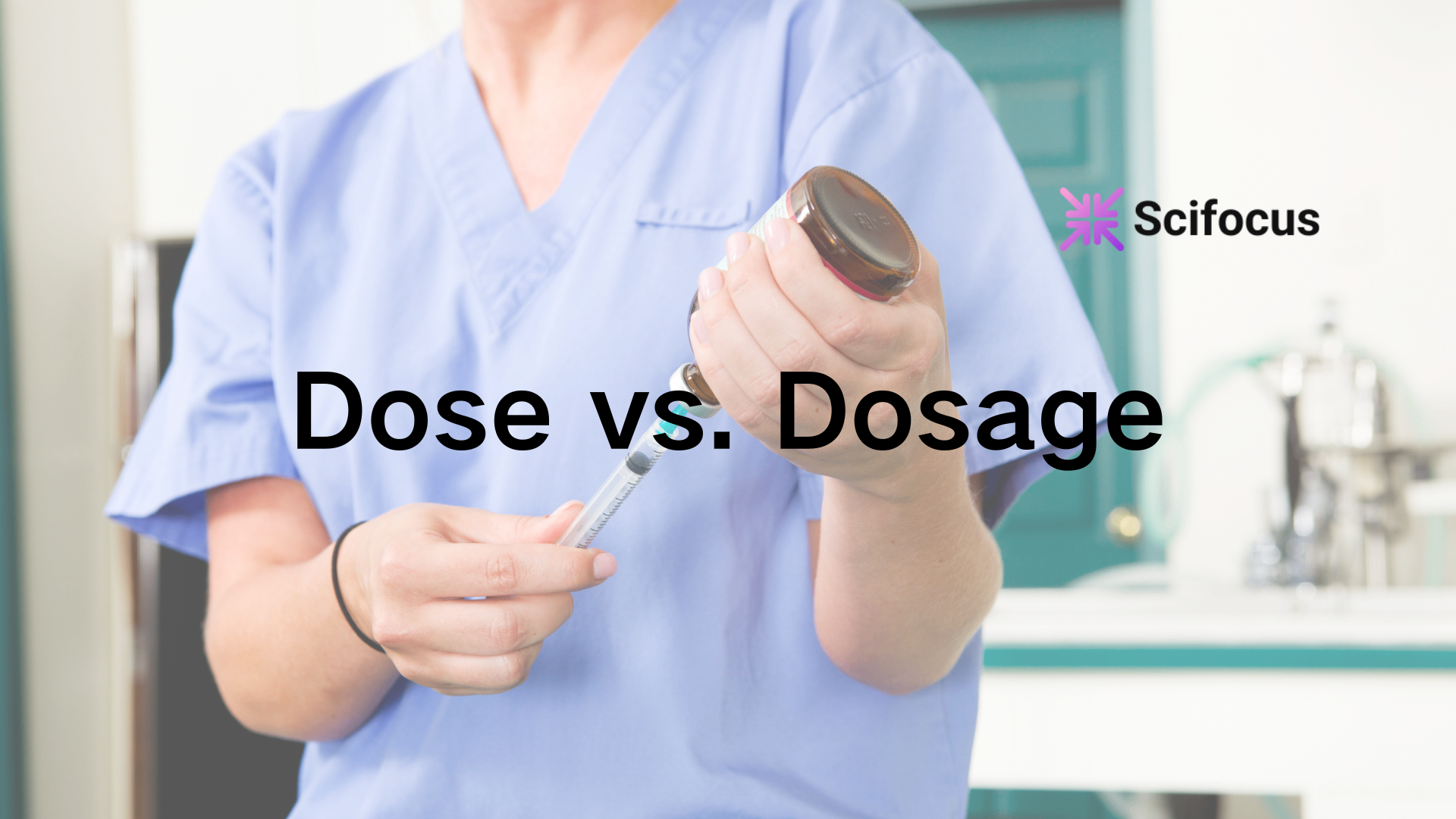Table of content
Dose and Dosage Definition: What's the Difference Between Them?

A dose is the specific amount of a medication or substance taken at one time, while dosage refers to the overall regimen—including the dose, frequency, and duration of administration. In simplest terms: dose = amount, dosage = schedule.
In academic writing, using terms accurately is crucial, especially when discussing dose versus dosage. You can use Scifocus to ensure your sentence structure and terminology usage are correct.
What Do “Dose” and “Dosage” Actually Mean?
Understanding the difference between these two terms matters far more than students initially expect—especially in pharmacology, clinical rotations, or laboratory work. The words sound nearly identical, and even experienced clinicians sometimes use them loosely in conversation. Yet in academic writing, prescriptions, research protocols, and safety guidelines, this distinction must remain clear and consistent.
To help clarify these definitions, major health authorities (such as the U.S. Food and Drug Administration, the Centers for Disease Control and Prevention, and the World Health Organization) consistently differentiate dose as a single measurable quantity and dosage as the planned therapeutic regimen.
Before we explore examples and common confusions, let’s break down each term on its own.
What Is a Dose?
A dose refers to the exact amount of a medication or substance taken at one time. It is quantitative—measurable, concrete, and tied directly to a moment of administration.
Pharmacy textbooks often define it as the measured quantity of a drug delivered for one administration, which may be expressed in milligrams, micrograms, units, milliliters, drops, or inhalations.
For instance:
- A 500 mg tablet of amoxicillin
- A 2-unit injection of insulin
- A 5 mL spoonful of acetaminophen syrup
- One puff of a salbutamol inhaler
Each is a dose because it occurs once and has a fixed amount.
In professional contexts, the “dose definition pharmacy example” often involves controlled substances or narrow therapeutic index drugs. For example, a chemotherapy dose might be calculated based on body surface area (mg/m²) to minimize toxicity—an approach widely discussed in clinical pharmacology.
Because students frequently encounter linguistic confusion in scientific writing, it may help to learn about other distinctions as well. Scifocus has several language-specific comparisons, such as fewer vs. less and disc vs. disk that show how subtle differences in wording matter greatly in academic contexts.
What Is a Dosage?
A dosage describes the complete therapeutic plan—the amount of a drug per dose, the frequency of administration, and the duration of treatment.
In short, dosage answers questions like:
- How much each time?
- How often?
- For how long?
A typical dosage instruction looks like:
500 mg, three times a day for 7 days
This includes:
- Dose: 500 mg
- Frequency: three times a day
- Duration: 7 days
Together, these components form the dosage.
Medical authorities such as the Mayo Clinic and MedlinePlus consistently describe dosage as the therapeutic pattern intended to achieve pharmacological benefit while minimizing side effects.
In academic writing, especially when preparing laboratory reports or manuscripts, the use of dosage must remain precise to avoid misinterpretation—much like selecting the correct spelling between modelling or modeling in scientific contexts.
Why Do Students Confuse Dose and Dosage So Often?
You’ve probably heard classmates use the terms interchangeably—sometimes even instructors use them casually, especially during busy lab hours or clinic days. The confusion usually stems from three issues:
- They share the same root word.
- Everyday conversation is less strict than academic communication.
- Many textbooks mention them in adjacent sections, making them appear similar.
Yet pharmacology requires clarity. A researcher quantifying “dose response” must avoid blurring it with “dosage regimen,” or the data interpretation becomes ambiguous.
This distinction is as important as correctly distinguishing led or lead when writing research papers.
What Is the Difference Between Dose and Dosage With Example?
The shortest accurate comparison is:
- Dose = amount administered once
- Dosage = therapeutic schedule (dose + frequency + duration)
Example:
A physician prescribes:
“Take 10 mg of cetirizine once daily for 14 days.”
- Dose: 10 mg
- Dosage: 10 mg once daily for 14 days
When exams ask the “difference between dose and dosage with example,” use the explanation above—it is clear, complete, and academically acceptable.
What Are the Five Key Differences Between Dose and Dosage?
Although dose and dosage relate to the same medication, they differ in multiple dimensions. Below are the most academically recognized distinctions:
1. Scope
- Dose is a single quantity.
- Dosage includes multiple variables.
2. Function
- Dose expresses “how much.”
- Dosage expresses “how much, how often, and for how long.”
3. Clinical Application
- Dose is used when preparing or administering medication.
- Dosage is used when prescribing or planning treatment.
4. Measurement
- Dose uses measurable units (mg, mL).
- Dosage uses temporal patterns (per day, per week).
5. Research Relevance
- Dose matters in pharmacokinetics: absorption, distribution, metabolism.
- Dosage matters in pharmacodynamics: effect over time.
These distinctions often appear on exams, and understanding them prevents errors in dosage calculations.
What Is the Difference Between Dose, Dosage, and Dosage Form?
This is where many students pause—rightfully so. The introduction of dosage form adds another dimension.
- Dose = amount
- Dosage = regimen
- Dosage form = physical form of the drug
Dosage forms include:
- tablets
- capsules
- injections
- syrups
- inhalers
- patches
- suppositories
For example, ibuprofen may have:
- a dose of 200 mg
- a dosage of 200 mg every 6 hours
- a dosage form of oral tablet
The WHO essential medicines list emphasizes that dosage form determines how the drug is delivered and absorbed—two crucial variables in clinical pharmacology.
This distinction is parallel to familiar linguistic contrasts explained by SciFocus, such as disc vs. disk.
How Does Pharmacology Explain Dose vs. Dosage?
Pharmacology formalizes the distinction in more scientific terms:
Dose → Pharmacokinetics (PK)
It influences:
- absorption rate
- peak plasma concentration
- bioavailability
- elimination half-life
Dosage → Pharmacodynamics (PD)
It influences:
- therapeutic effect
- sustained plasma concentration
- toxicity risk
- clinical outcome
For students studying PK/PD curves, understanding dose versus dosage is essential for interpreting:
- EC50 (effective concentration)
- LD50 (lethal dose)
- AUC (area under the curve)
These values depend on the dose, but the therapeutic pattern—the dosage—determines how plasma levels behave over time.
What Are Practical Examples of Dose vs. Dosage?
These examples cover common exam questions, especially those asking for “dose vs dosage examples” or “is dose and dosage the same.”
Antibiotics
- Dose: 500 mg amoxicillin
- Dosage: 500 mg three times daily for 7 days
Pain medication
- Dose: 200 mg ibuprofen
- Dosage: 200 mg every 6 hours as needed, not exceeding 1200 mg/day
Inhalers
- Dose: 1 puff albuterol
- Dosage: 1–2 puffs every 4–6 hours
Melatonin
- Dose: 3 mg
- Dosage: 3 mg nightly before sleep for 5–10 days
Caffeine
- Dose: 100 mg from one cup of coffee
- Dosage: depends on daily intake—e.g., 100 mg every morning
Notice how the dose is always a single figure, while the dosage outlines a pattern.
Why Is Proper Terminology So Important in Health Sciences?
Accurate terminology prevents errors. Misunderstanding dose and dosage can lead to:
- subtherapeutic treatment
- toxic overdose
- incorrect research reporting
- wrong exam answers
- miscommunication in clinical practice
Clinical guidelines from reputable sources such as the CDC emphasize that dosage instructions must be followed precisely, and incorrect dose interpretation remains a common cause of medication-related incidents.
This level of precision mirrors the linguistic care discussed in SciFocus blogs such as led or lead—because small differences can have large consequences in academic writing.
Are Dose and Dosage the Same?
No. They are related but not interchangeable.
- Dose refers to the amount taken once.
- Dosage refers to the therapeutic regimen.
This distinction should always remain clear in exams, research papers, and clinical records.
FAQs
What is the simplest dose and dosage definition?
A dose is the quantity of a drug taken at one time, while dosage is the regimen, including the amount, frequency, and duration.
What is dosage in pharmacy?
In pharmacy, dosage refers to the planned schedule of drug administration—amount per dose, frequency, and treatment length—designed to achieve therapeutic effect safely.
Are dose and dosage used differently in pharmacology?
Yes. Pharmacology uses dose for single-administration measurements and dosage for therapeutic patterns influencing pharmacodynamics over time.
How do I explain dose vs dosage in an exam answer?
Use this structure:
“Dose = specific amount. Dosage = regimen (amount + frequency + duration). For example, 500 mg is a dose; 500 mg three times daily for 7 days is a dosage.”
What is the difference between dose, dosage, and dosage form?
Dose = amount
Dosage = regimen
Dosage form = physical form of the drug (tablet, capsule, injection, etc.)
Did you like this article? Explore a few more related posts.
Start Your Research Journey With Scifocus Today
Create your free Scifocus account today and take your research to the next level. Experience the difference firsthand—your journey to academic excellence starts here.
